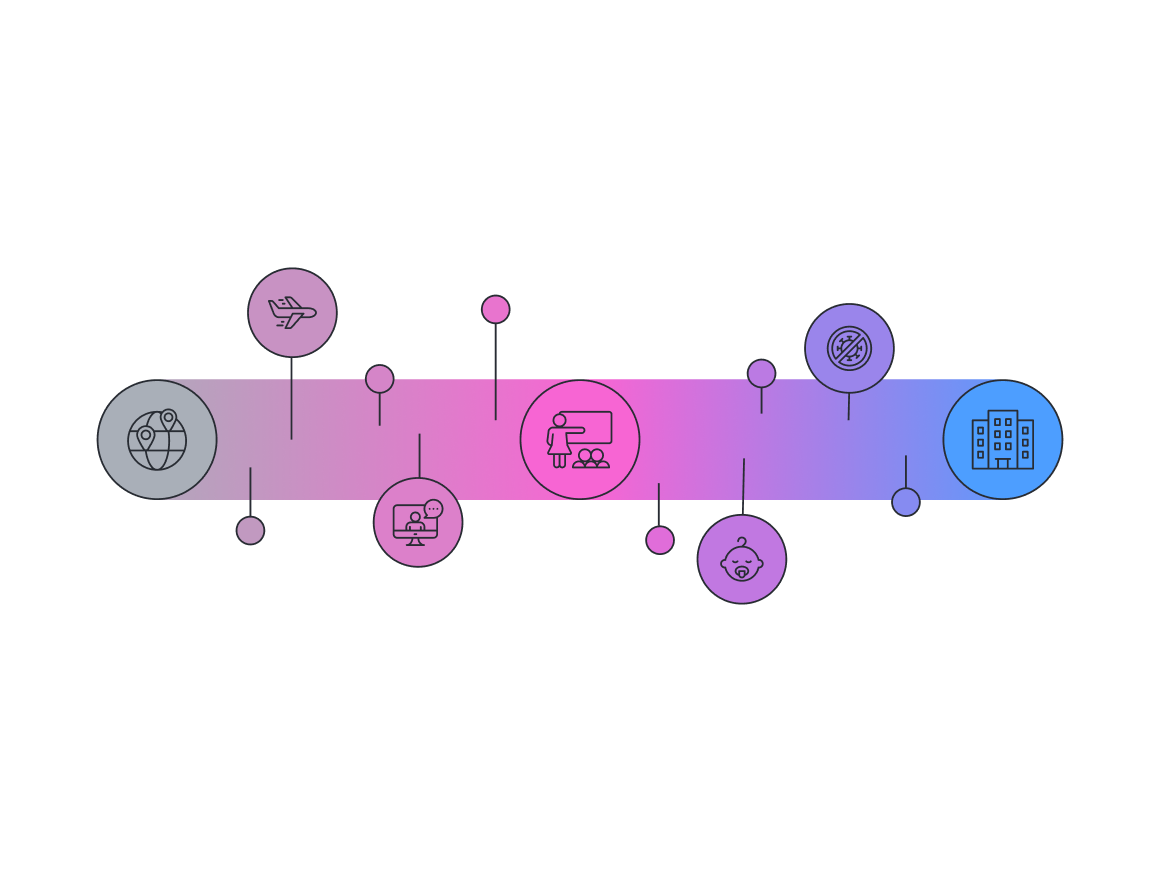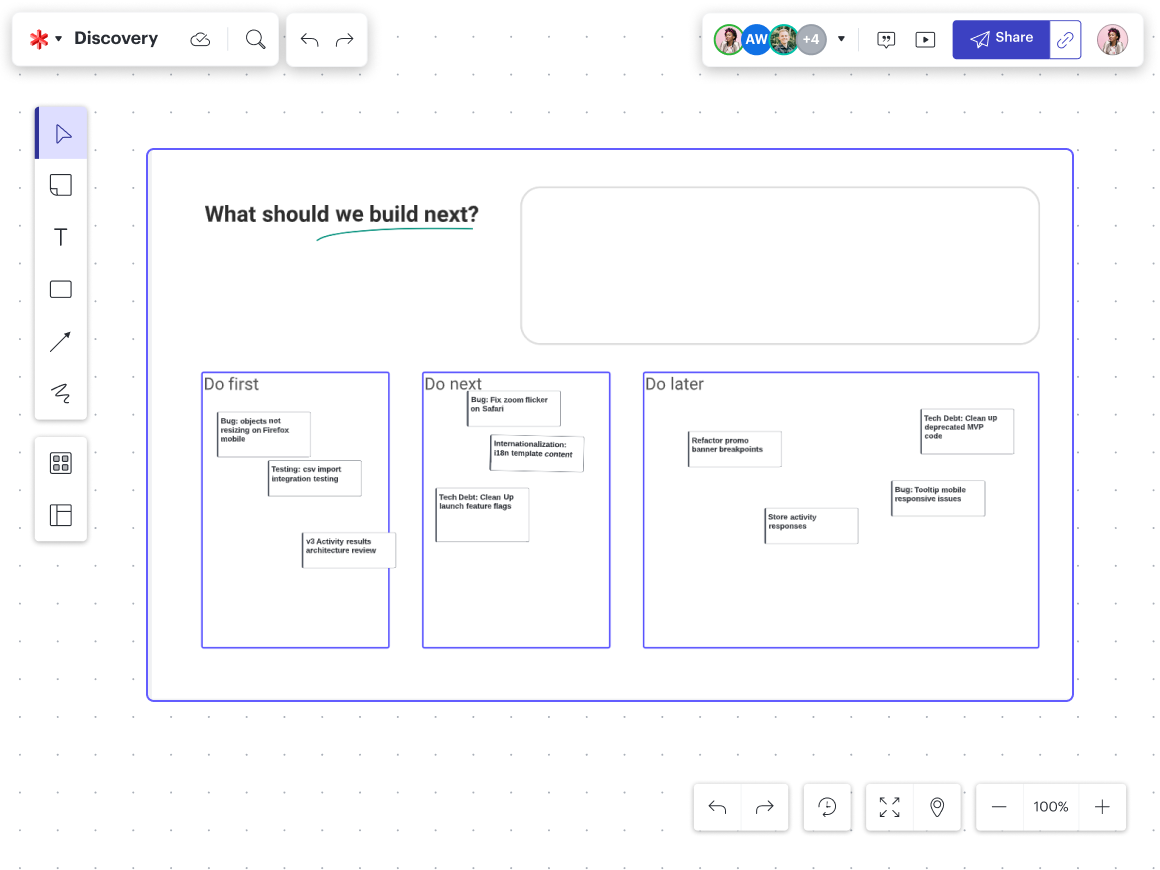
5 visual collaboration trends to watch out for in 2024
Reading time: about 11 min
2024 is shaping up to be an exciting year for visual collaboration. We’ve seen incredible changes over the past few years, especially since the start of the pandemic. Hybrid and remote work shaped our perspectives and challenged the status quo. Now, we’re seeing advancements like AI sweep the industry.
What does this mean? Well, we’re standing on the threshold of a shift. AI will automate routine tasks. Collaboration will be more equitable. Digital spaces are becoming increasingly interactive. In the midst of these changes, a new opportunity emerges.
For perhaps the first time, workers can be more creative and strategic than ever.
Visual collaboration is a keystone in this shift and is set to define the future of work. The five trends we’ll cover below highlight the reasons why.
1. Building with AI
AI is the buzzword falling from the mouths of every business leader, LinkedIn influencer, and knowledge worker.
Nathan Rawlins, chief marketing officer at Lucid, puts it simply, saying:
“AI is making the pace of change back in the dotcom boom seem slow.”
In 2024, you can expect to see visual collaboration leverage AI further to enhance its inherent characteristics. This will continue to make visual collaboration platforms the ideal environment for collaborating, innovating, learning, and creating.
AI changes how teams interact and create because it can catapult a brainstorming session past the dreaded blank page. Is everything that AI generates usable? Certainly not, but it jump-starts the flow of ideas. Within a visual collaboration platform, AI is a springboard for creativity.
Beyond ideation, AI is a powerful content summarizer. The technology can condense tons of information into digestible chunks. Sometimes, the hardest part of a project is wrapping your mind around the concepts and ideas. AI helps with this hurdle by synthesizing information and thus streamlining collaboration and decision-making.
Accelerating the pace of learning is at the heart of the AI conversation. Visual collaboration is all about helping teams learn faster through powerful visuals; in this, visual collaboration and AI are a well-suited pairing.
Dan Lawyer, chief product officer at Lucid, touches on this topic by saying:
“AI allows for a lot more discovery and permutation on a topic. The effort I have to put in to gain expert knowledge about something has been lowered quite a bit by treating AI as my collaborator. That allows me to rapidly pursue more threads before converging them and driving towards a decision. It also lets me be more creative and more inspired by different fields of thought.
Lawyer continues by talking about how AI will transform the decision-making process by accelerating the learning process.
“When looking at AI and decision-making in the next year, I don’t think AI will be making the strategic decisions, but instead will recommend and inform tactical decisions (i.e., telling a salesperson which accounts to reach out to that day and helping create a task list). This will enable knowledge workers to think faster or act on that recommendation faster if it’s good. AI might also recommend ways of doing work to help accelerate the process, such as choosing the tool or format so that people don’t have to spend as much time making those kinds of tactical decisions.”

5 common challenges AI solves
Check out our recent blog post about using AI throughout your project workflow.
Go now2. Supporting a spectrum of collaboration
The past couple of years have seen visual collaboration platforms working to accommodate hybrid and remote work. The evolution of these platforms remains attuned to the diverse needs of modern teams, but the conversation extends beyond that in 2024.
During the resurgence of return-to-office initiatives, there’s a deep need for companies to figure out how to navigate this nuanced landscape. Years ago, we might have broken down the definitions of how people work into three categories: in-office, remote, or hybrid. It’s no longer that simple. Instead, we have an entire spectrum of work models.

In 2024, we’re not trying to define remote or hybrid work—we’re pivoting and talking about that whole spectrum. This shift necessitates creating cohesive, central spaces capable of uniting team members dispersed across locations and working styles.
Visual collaboration is at the forefront of this conversation. These platforms offer a customizable shared workspace that transcends constructed boundaries of space and time. Looking ahead, visual collaboration platforms will continue to add features supporting this idea.
As an example, Lucid recently added integrations allowing teams to incorporate video clips into their boards to provide more context. As a whole, integrations like this are essential to promoting greater collaboration equity. By providing a wide range of integrations, visual collaboration platforms make it possible for businesses to reduce software spend and remove tech silos.
What about asynchronous collaboration?
Simultaneously, there will be a continued focus on asynchronous work. Bryan Stallings, chief evangelist at Lucid, said:
“With increased diversity of thought, we don’t want to miss out on the valuable thoughts of those we do hire! This means if someone needs to pick up a kid from school, they can ‘join’ the meeting asynchronously to add their ideas to a visual thought process. Team members on the other side of the world can now participate in valuable conversations at a time their brains are turned on, rather than having to stay up or wake up in the middle of the night.”
Asynchronous work means that all voices can be heard. This also lends to the trends of making work more accessible for everyone.
Constellation Research's report, “The Leading Trends in Visual Collaboration for 2024,” states:
“In today’s global work environment, the organization places a strong emphasis on asynchronous collaboration. Lucid has proven to be instrumental in this regard. The tool’s capabilities have been especially beneficial for teams operating in a hybrid work model, bridging the gap between remote and onsite collaborators.”
Lucid Software leads the asynchronous collaboration conversation and will continue in 2024.
As Stallings said:
“It will become second nature for any of us to switch between synchronous and asynchronous collaboration, and we will say, ‘How did we ever work any other way?’”

Asynchronous collaboration guide
Want more tips, tricks, and tools to master asynchronous collaboration? Check out Lucid’s comprehensive guide.
Read more3. Prioritizing collaboration equity
In 2023, there was a push to make collaborative workspaces more accessible and inclusive. This effort began when organizations had to try and accommodate remote employees as some workers return to the office. At the same time, prioritizing neurodiversity and fostering psychological safety became mantras for organizations big and small.
During this push, visual collaboration platforms took center stage. Visual collaboration platforms sought (and will continue to seek) ways to give everyone—no matter their location or time zone—an equal voice.
As companies started discussing how to give everyone a seat at the table, visual collaboration platforms were paving the way. In this endeavor, these platforms created an environment where bringing all teams together was natural.
In 2024, we’re thrilled to say that this will be an ongoing initiative and that it will take on additional meaning. Teams are beginning to discuss collaboration equity—how to make collaboration accessible for everyone. We’re no longer boxing teams into remote, hybrid, or in-office. As we discussed above, there’s an entire spectrum of working locations, styles, and preferences now.
Visual collaboration platforms are building out exciting new tools to allow for greater equity. For example, Lucid recently released Visual Activities, a feature designed to engage all team members equally in brainstorming, prioritizing, planning, voting, and decision-making.

Stallings talks about the importance of choosing the right platform to enable collaboration equity:
“A big part of collaboration equity, moving into this next year, is creating a focus on better collaboration platforms, like the Lucid Visual Collaboration Suite. Then, people realize that when they collaborate on these platforms, it will create equity or at least provide an opportunity to create greater equity.”
4. Creating immersive and interactive experiences
Constellation Research's report, “The Leading Trends in Visual Collaboration for 2024,” states:
“The realm of user interface (UI) and UX design is undergoing a transformative shift, with a focus on creating more immersive and interactive experiences. This evolution is poised to significantly elevate the capabilities and appeal of visual collaboration tools.”
Visual collaboration platforms are going to focus more on incorporating this philosophy into their user experience in the upcoming year.
These platforms have already transcended the traditional boundaries of work and documentation. Teams are no longer confined to a page in a text editor or spreadsheet. They can explore ideas and processes on an infinite canvas. They’re not siloed, either. They can collaborate, create, communicate, and convey complex ideas with ease.
Visual collaboration platforms redefine the workplace by providing environments where creativity, collaboration, and innovation thrive organically. In 2024, platforms will find new ways to leverage the boundaryless arena.
To continue from Constellation Research’s report:
“The future of visual collaboration is set to be a transformative journey, marked by advancements in UI, UX, and integration with emerging technologies. As these platforms evolve, they are moving beyond traditional boundaries, embracing larger screens and projected displays that offer expansive and detailed views and facilitating intricate multi-user interactions.”
5. Shortening the gap between ideation and execution with accessible data
Data-driven decision-making is top of mind for organizations. Today’s technology makes collecting data easier than ever, which means it’s more accessible. Because data is so readily available, companies can act quickly based on concrete metrics—something that might have taken much longer in the past.
Now, the ability to source and synthesize data quickly shortens the gap between ideation and execution. It allows organizations to make strategic decisions fast.

Guide to strategic decision-making
Check out our guide to strategic decision-making for more tips and tricks from experts.
Check it outVisual collaboration platforms are paving the way with database integrations and capabilities. Data visualization takes accessible and digestible data to a whole new level, making it possible for your teams to grasp essential information at a glance.
When visual collaboration platforms have integrated databases, users can quickly access, manipulate, or visualize real-time data without switching between tools. It’s seamless. This capability fosters a truly dynamic environment. Having readily available and visible data encourages teams to make agile decisions based on up-to-date information.
As organizations grow, they’ll more than likely be pulling data in from various sources. Visual collaboration software is going to continue pushing the envelope here, making it possible for teams to visualize data from multiple sources in a comprehensive way.
In 2024, with an increased focus on data visualization and intelligent features, visual collaboration platforms will become more capable of providing data-driven insights. This means teams can make data-backed decisions in the same space as they garnered the insights and immediately act on those decisions.
According to Constellation Research’s report, Lucid is leading the way in this space:
“Database integration and data visualization are pivotal advances that can be significantly improved by visual collaboration platforms, with vendors such as Lucid pioneering the way in this feature category in particular.”

The most intelligent visual collaboration platform
Curious as to why Lucid is an industry leader when it comes to intelligent visual collaboration?
Learn moreConcluding thoughts: Enabling creative thinking and smarter strategy
With the rate of advancement, walking into each new year can feel like entering an entirely new world. 2024 might seem overrun by technology, but there’s an emerging counterbalance. We’re starting to see a quest to humanize work. The more we allow AI and other technologies to streamline (if not entirely automate) routine tasks, the more we free the workforce to engage with creative and strategic thinking.
New generations entering the workforce are prioritizing purpose and authenticity in their output. Content that’s obviously created by humans will become more of a premium product. As Rawlins says:
“There will be a premium to teams who can bring a bit more analog to marketing, and there will be a push for things that are clearly created by humans. Overall, the playbook will diversify.”
This trend extends far beyond marketing and touches every department of every organization. Teams who can leverage these exciting advancements to their benefit and continue to innovate on top of that will dominate the space this year.
Each of these trends discussed today propel us closer to this world we’ve described. AI acts as a springboard for our creativity, collaboration equity brings innovative thoughts from all team members to the table, immersive and interactive spaces inspire great ideas, and having data more readily accessible and understandable leads to smarter strategies.
Visual collaboration is the center of everything we’ve discussed in this article. As Rawlins continued to say:
“Visual collaboration is going to continue to deepen into business processes, making it more focused on core activities and getting things done while tying it to key business initiatives.”
Inherently flexible, creative, and interactive, visual collaboration has a tangible quality you can’t find in any other software solution. Translating abstract ideas into actionable strategies through inspiring visuals aligns perfectly with the modern workforce.
Constellation Research’s report states:
“The future of visual collaboration is a horizon where technology deeply amplifies human potential, fostering deeper connections, insights, and innovations.”

Read the full Constellation Research report
Are you interested in the future of visual collaboration? Be sure and check out Constellation Research’s report, “The Leading Trends in Visual Collaboration for 2024.”
Download for freeAbout Lucid
Lucid Software is the leader in visual collaboration and work acceleration, helping teams see and build the future by turning ideas into reality. Its products include the Lucid Visual Collaboration Suite (Lucidchart and Lucidspark) and airfocus. The Lucid Visual Collaboration Suite, combined with powerful accelerators for business agility, cloud, and process transformation, empowers organizations to streamline work, foster alignment, and drive business transformation at scale. airfocus, an AI-powered product management and roadmapping platform, extends these capabilities by helping teams prioritize work, define product strategy, and align execution with business goals. The most used work acceleration platform by the Fortune 500, Lucid's solutions are trusted by more than 100 million users across enterprises worldwide, including Google, GE, and NBC Universal. Lucid partners with leaders such as Google, Atlassian, and Microsoft, and has received numerous awards for its products, growth, and workplace culture.
Related articles
5 red flags to look out for when evaluating visual collaboration platforms
Learn how to uncover critical weaknesses in visual collaboration platforms before you commit.
Why a return-to-office policy isn't a silver bullet to business problems
Looking to increase productivity, collaboration, and innovation? Focus on how teams work together—not where.
What makes Lucid the most intelligent visual collaboration solution—and why does it matter?
From data-backed visualizations to automation and AI, find out what makes Lucid the most intelligent visual collaboration solution.
Lucid’s best of 2023
See the new capabilities that ushered in the next generation of visual collaboration.